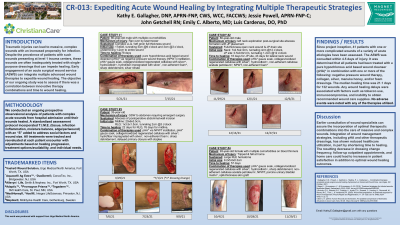Back

Clinical Research
(CR-013) Expediting Acute Wound Healing by Integrating Multiple Therapeutic Strategies

Co-Author(s):
Emily Alberto, MD – Surgical Resident, Surgical Critical Care, Christiana Care; Luis Cardenas, DO, PhD – Acute Surgical Wound Service Medical Director, Surgical Critical Care, Christiana Care; John Getchell, RN – Research Coordinator, Trauma Research, Christiana Care; Jessie Powell, APRN-FNP-C – Acute Surgical Wound Service NP, Surgical Critical Care, Christiana Care
<b>Introduction</b>: Traumatic injuries can lead to massive, complex wounds with an increased propensity for infection. Despite the prevalence of patients with such wounds presenting at level 1 trauma centers, these wounds are often inadequately treated with single-purpose dressings that can impede healing. Early engagement of an acute surgical wound service (ASWS) can integrate multiple advanced wound therapies to expedite wound healing. The objective of our ongoing study was to assess if there was a correlation between innovative therapy combinations and time to wound healing.<br/><br/><b>Methods</b>: We conducted an ongoing prospective observational analysis of patients with complex acute wounds from hospital admission until their wounds healed. A standardized assessment protocol incorporated T.I.M.E. (tissue, infection /inflammation, moisture balance, edge/periwound) 3 with an “S” added to address social factors and wound size. All treatments were tracked and reevaluated at each patient encounter with adjustments based on healing progression, treatment options/availability, and individual needs.<br/><br/><b>Results</b>: Since project inception, 41 patients with one or more complicated wounds of a variety of acute etiologies have been assessed. The ASWS was consulted within 4.5 days of injury. It was determined that all patients had been treated with a pure hypochlorous acid based wound cleanser (pHA)* in combination with one or more of the following: negative pressure wound therapy, collagen, silver, manuka honey, and/or foam dressings. The median healing time was 21.1 days for 132 wounds. Any wound healing delays were associated with factors such as tobacco use, immunocompromise, and inability to obtain recommended wound care supplies.<br/><br/><b>Discussion</b>: Earlier consultation of wound specialists can assure the incorporation of optimal therapeutic combinations into the care of massive and complex wounds. Integration of wound management strategies, including pHA and other therapeutic dressings, has shown reduced healthcare utilization, in part by shortening time to healing. The resulting decrease in dressing change frequency, follow-up outpatient appointments, and home care could lead to increases in patient satisfaction in addition to optimal wound healing outcomes.<br/><br/><b>Trademarked Items</b>: *Vashe® Wound Solution, Urgo Medical North America, Fort Worth, Texas, USA<br/><br/><b>References</b>: Negut, I., Grumezescu, V., & Grumezescu, A. M. (2018). Treatment strategies for infected wounds. Molecules (Basel, Switzerland), 23(9), 2392. doi.org/10.3390/molecules23092392
Schultz, G.S., Sibbald, R.G., Falanga, V., Ayello, E.A., Dowsett, C., Harding, K., Romanelli, M., Stacey, M.C., Téot, L., & Vanscheidt, W. (2003). Wound bed preparation: A systematic approach to wound management. Wound Repair and Regeneration, 11: S1–S28. doi:10.1046/j.1524-475X.11.s2.1.x
Sen C. K. (2019). Human Wounds and Its Burden: An Updated Compendium of Estimates. Advances in wound care, 8(2), 39–48. https://doi.org/10.1089/wound.2019.0946<br/><br/>
Schultz, G.S., Sibbald, R.G., Falanga, V., Ayello, E.A., Dowsett, C., Harding, K., Romanelli, M., Stacey, M.C., Téot, L., & Vanscheidt, W. (2003). Wound bed preparation: A systematic approach to wound management. Wound Repair and Regeneration, 11: S1–S28. doi:10.1046/j.1524-475X.11.s2.1.x
Sen C. K. (2019). Human Wounds and Its Burden: An Updated Compendium of Estimates. Advances in wound care, 8(2), 39–48. https://doi.org/10.1089/wound.2019.0946<br/><br/>

.png)